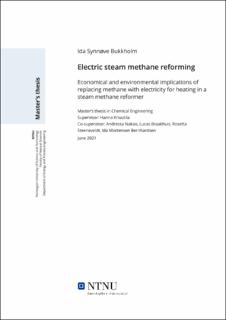| dc.contributor.advisor | Knuutila, Hanna | |
| dc.contributor.advisor | Nakao, Andressa | |
| dc.contributor.advisor | Braakhuis, Lucas | |
| dc.contributor.advisor | Steeneveldt, Rosetta | |
| dc.contributor.advisor | Bernhardsen, Ida Mortensen | |
| dc.contributor.author | Bukkholm, Ida Synnøve | |
| dc.date.accessioned | 2021-09-28T18:24:33Z | |
| dc.date.available | 2021-09-28T18:24:33Z | |
| dc.date.issued | 2021 | |
| dc.identifier | no.ntnu:inspera:82941058:13540527 | |
| dc.identifier.uri | https://hdl.handle.net/11250/2785385 | |
| dc.description.abstract | Grønn energi har fått en trekkraft som et resultat av økt fokus på bærekraft, og det blir forsket på mer enn noen gang før. Ettersom fossile brennstoff er skadelig for miljøet, er det på tide at de byttes ut. Hydrogen er en god erstatning, som det vanligste elementet i universet og med sin høye gravimetriske energi.
Dette arbeidet fokuserte på hydrogenproduksjonsmetoden for dampmetanreformering (SMR) med aminbasert karbonfangst. Oppvarmingen av hovedreformeren viste rom for forbedring, da varmen ble tilført fra forbrenning av naturgass. En idé er å bruke elektrisk varme istedenfor. Elektrisk SMR ble sammenlignet med konvensjonell SMR i drifts- og kapitalkostnader, nullpunktspris og CO2-utslipp. Begge teknologiene ble simulert i Aspen Hysys.
Driftskostnadene til elektrisk SMR ble funnet til å være 0,13 USD / kg H2 billigere enn konvensjonell SMR. Beregninger av kapitalinvesteringene viste at på grunn av de lavere driftskostnadene, kunne investeringene være høyere basert på de nullpunktsprisen.
Basert på simuleringene ble det funnet at hovedutslippene av CO2 i konvensjonell SMR med karbonfangst stammer fra oppvarmingen av hovedreformeren. Ved å bytte til en elektrisk oppvarmet SMR med fornybar elektrisitet, ble utslippene funnet å være redusert 77 %. Viktigheten av fornybar elektrisitet ble også demonstrert. Oppsummert ser man at ved å varme opp hovedreformeren i SMR elektrisk kan man få ned både kostnader og utslipp. Elektrisk SMR kan være en nyttig teknologi i overgangen mot en hydrogenøkonomi. | |
| dc.description.abstract | Green energy has gained traction as a result of a growing focus on sustainability, and it is being investigated like never before. Because fossil fuels are intrinsically harmful to the environment, they must be replaced. Hydrogen is a viable substitute since it is the most abundant element in the universe and has a high gravimetric energy.
This work focused on the hydrogen production method of steam methane reforming (SMR) with amine-based carbon capture. The heating in the primary reformer, supplied by the combustion of natural gas had the opportunity to be improved. That improvement was to replace the combustion of natural gas with electrical heating. The conventional SMR was compared to the electrically heated SMR in terms of
operational and capital costs, levelized cost of hydrogen, and CO2 emissions. Both technologies were simulated in Aspen Hysys.
The operational cost of electrical SMR was found to be 0.13 USD/kg H2 cheaper than conventional SMR. Calculations of the capital investments showed that because of the lower operational costs, the capital expenditures could be higher based on the levelized cost of hydrogen. Based on the simulations, it was found that the main CO2 emissions in conventional SMR with carbon capture stem from the heating of the primary reformer. By switching to an electrically heated SMR with renewable electricity, emissions were found to be reduced by 77%. The importance of renewable electricity was also demonstrated.
In summary, by electrically heating the primary reformer in SMR there can be improvements in both costs, and emissions. The electrically heated SMR can be a useful technology in the energy transition towards a hydrogen economy. | |
| dc.language | eng | |
| dc.publisher | NTNU | |
| dc.title | Electric steam methane reforming - Economical and environmental implications of
replacing methane with electricity for heating in a
steam methane reformer | |
| dc.type | Master thesis | |
